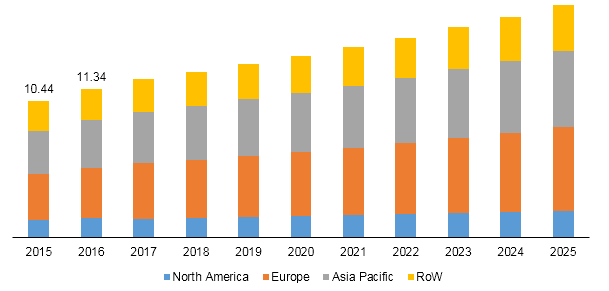
Sesame Seeds Market Size And Forecast, By Application (Food, Pharmaceuticals), By Region (North America, Europe, Asia Pacific, Rest of the World) And Trend Analysis, 2015 - 2025
- Published: December, 2018
- Format: Electronic (PDF)
- Number of pages: 65
- Industry: Food & Beverages
Industry Insights
The global sesame seeds market demand was valued USD 12.07 billion in 2017 and is projected to exhibit a CAGR of 4.9% from 2017 to 2025. Increasing application of the product in confectionery and bakery sectors on account of its high content of unsaturated fats is expected to have a positive impact on the market. Furthermore, rising adoption of sesame seed extract as an anti-oxidant in pharmaceutical sector is expected to remain a favorable factor in the market.
Global sesame seeds market revenue, by region, 2015 - 2025 (USD Billion)

Sesame seed is used as a functional ingredient in manufacturing various food products as it is rich in calories comprising of 50% fat, 23% carbohydrates, 18% protein, and 12% dietary fiber. Growing bakery sector in developed countries, such as U.S. and Japan on account of new product developments pertaining to dietetic products is expected to boost the product demand in future. Furthermore, rising concerns regarding adverse effects associated with consumption of synthetic pharma drugs on a global level is expected to expand the scope of herbal medicines. Increasing demand for herbal medicines is expected to promote incorporation of the product as an excipient for drug delivery.
Segmentation by Application
• Food
• Pharmaceutical
In 2017, the food industry dominated the sesame seeds market and accounted for more than 70% of the overall revenue. Rising awareness of healthy food as a result of growing concerns regarding cardiovascular disorders and digestive diseases is projected to have a positive impact on the market growth. In addition, growing acceptance of sesame seed-based sauces, marinades, and seasonings in developed economies, including Greece and the Netherlands owing to penetration of Agro-African food culture on a domestic level is expected to contribute significantly to the growth. Some of the European countries make use of sesame seeds oil as an olive oil substitute. Furthermore, the product finds its application in Japanese fish dishes, including sushi and salad oil.
Pharmaceutical is expected to emerge as a prominent application in the market and generate a revenue of USD 4.75 billion by 2025. Sesame seeds are natural laxatives that are useful for treating diseases including, constipation and digestive problems. Moreover, they act as anti-oxidants for treatment of carcinogenic disorders.
The product is also used for Ayurvedic medicinal purposes, such as massage. Growing penetration of medical tourism in countries, including South Africa, Sri Lanka, and Maldives on account of supportive government policies for renovating spots is expected to open novel growth opportunities for the market in future.
Segmentation by Region
• North America
• Europe
• Asia Pacific
• Rest of the World
In 2017, Asia Pacific accounted for 32.7% share of the overall revenue. It is expected to expand at a CAGR of 5.7% from 2017 to 2025. The region has emerged as a prominent producer and consumer of sesame seeds on account of presence of a number of manufacturing units of bakery and confectionary.
Europe is expected to be emerge highly lucrative in the sesame seeds market and exhibit a CAGR of 5.1% from 2017 to 2025. The growth could be attributed to increasing awareness for organic products and shift in preference among consumers towards high nutritional food. Countries, such as Greece, Germany, the Netherlands, and Poland were the leading importers of the product in 2017. Europe is expected to remain a key consumer of sesame owing to widespread usage of the product by restaurants as an ingredient in preparation of various cuisines, including sushi, tahini, hummus, and eastern dessert.
Major exporters of sesame seeds include China, India, and some African countries, including Tanzania. According to a data by Food and Agriculture Organization (FAO), in 2016, Tanzania was the largest producer as well as exporter of sesame seeds. Favorable government policies in Tanzania for promoting the product’s farming output is expected to open new avenues for the market. Major countries importing sesame seeds from Tanzania are Singapore, Japan, Greece, Germany, The Netherlands.
Competitive Landscape
Price fluctuation on account of variation in demand and supply of the product is expected to remain a key challenge for the manufacturers. China and India are the largest producers of sesame seed and majority of global demand is fulfilled by these countries. Any failure in the sesame crop such as environmental impact and less production affects the global supply and price of sesame seed. This has increased dependency of various global suppliers on annual volume production output of countries, including China and India.
Key players operating in the sesame seeds industry include Bayer AG, Syngenta, Orienco, Selet Hulling PLC, SunOpta, SINDAN ORGANIC, and Archer Daniels Midland Company.

Choose License Type
- World's largest premium report database
- Transparent pre & post sale customer engagement model
- Unparalleled flexibility in terms of rendering services
- Safe & secure web experience
- 24*5 Research support service
